
Historical
and Cultural Context
Historical and Cultural
Context | Site
Map | On-Line
Resources | Rules
of Thumb | Glossary |
Quotes | WordList
| Co-Teachers - Doug
and Melissa | Gallery
E-Mail Doug at mrdoug@aznet.net
or Melissa atmelissa.granadatreehousestudio@gmail.com
daDa
- Artists
daDa (1915-1922)
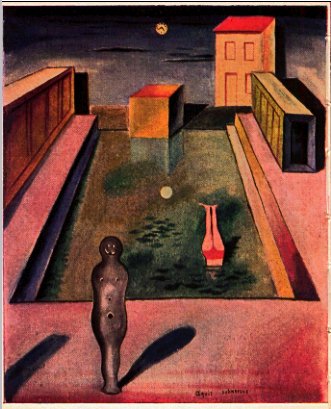
Max Ernst - Aquis submersus - 1919
http://www.peak.org/~dadaist/Art/index.html
An early twentieth century art movement which ridiculed
contemporary culture and traditional art forms. It was born as a
consequence of the collapse during World War I of social and moral
values which developed to that time. Dada artists produced works
which were nihilistic or reflected a cynical attitude toward social
values, and, at the same time, irrational-- absurd and playful,
emotive and intuitive. Less a style than a zeitgeist, Dadaists
typically produced art objects in unconventional forms produced by
unconventional methods. Several artists employed the chance results
of accident as a means of production, for instance. Literally, the
word dada means several things in several languages: it's French for
"hobbyhorse" and Slavic for "yes yes". Many artists associated with
this movement later became associated with Surrealism (http://www.artlex.com/ArtLex/d/dada.html).
"Hey, hey, young man - Dada isn't
an art-trend but an anti-art movement, a radical cultural revolution,
as a response to World War I ! Dada supported all types of
misunderstandings and confusions; as a principle, out of a mood, as a
fundamental opposition!" - http://www.mital-u.ch/Dada/index.html
Dada was initially manifested by a group of German artists who had
gone to Zurich to escape World War I. They later split up into two
groups with one returning to Berlin, while the other went to Paris.
There were also many associated manifestations of Dada throughout the
world, and in particular New York. The Parisian manifestation of Dada
eventually evolved into Surrealism.
Unlike the Italian Futurists before them who saw constant warfare
as a means to create a culture that existed for art, the Dadaists
proposed an anti-art that would destroy culture and therefore war. In
this regard, at the Cabaret Voltaire, a hangout for pacifists and
Bohemians of the day, Hugo Ball (1886-1926) invented a form of
anti-poetry in 1916:
I have invented a new genre of poems, Verse ohne Worte, (poems
without words) or Lautgedichte (sound poems), in which the balance of
the vowels is weighed and distributed solely according to the values
of the beginning sequence.
Top
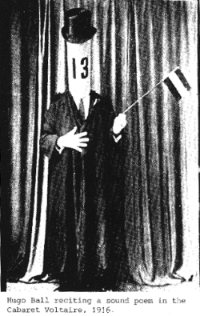
Ball is often cited as the 'inventor' of sound poetry (http://cadre.sjsu.edu/switch/sound/articles/wendt/folder6/ng65.htm).
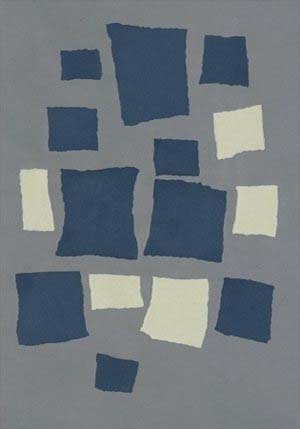
Jean Arp - Arrangement according to Laws of Chance
(Collage with Squares) - 1916-17 -
http://www.moma.org/collection/drawings/arp_arrangement.html
Art is a fruit that grows in
man, like a fruit on a plant, or a child in its mother's
womb. - Jean Arp
daDa
- Artists | Top
- Jean Arp
- Sophie Taeuber-Arp
- Hugo Ball
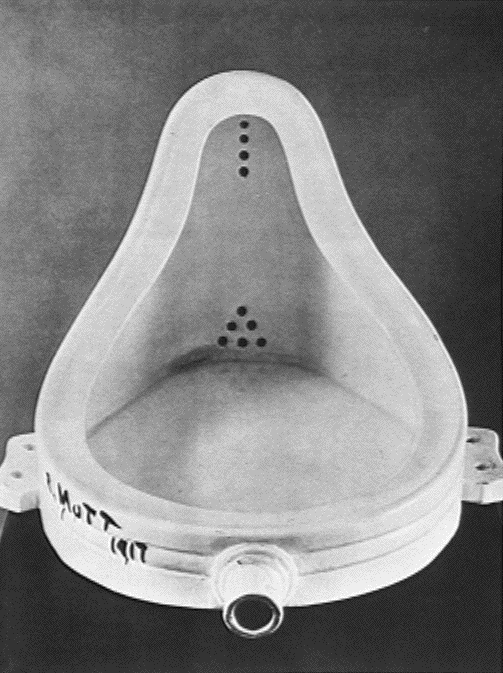
Marcel Duchamp - Fontaine - 1917 -
http://www.artlex.com/ArtLex/d/dada.html
- Marcel Duchamp
- Max Ernst
- Raoul Hausmann
- Marcel Janco
- Francis Picabia
Top

Man Ray - Cadeau -1921 (fabricated 1974) -
http://sheldon.unl.edu/HTML/ARTIST/Man_Ray/SS.html
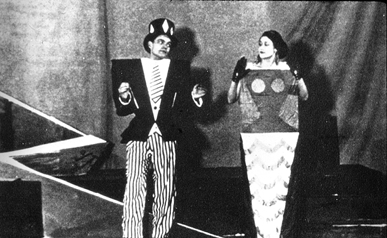
Scene from "The Gas Heart" by Tristan Tzara.
Costumes designed by Sonia Delaunay, Theatre Michel, Paris, July 6-7,
1923. -
http://www.emory.edu/ENGLISH/DRAMA/HistDrama2/SymbolImage.html
SAMPLE POEM | Top
DADA is a virgin microbe
DADA is against the high cost of living
DADA limited company for the exploitation of ideas
DADA has 391 different attitudes and colours according to the sex of
the president
It changes -- affirms -- says the opposite at the same time -- no
importance -- shouts -- goes fishing.
Dada is the chameleon of rapid and self-interested change.
Dada is against the future. Dada is dead. Dada is absurd. Long live
Dada.
Dada is not a literary school, howl.
--Tristan Tzara - http://www.english.upenn.edu/~afilreis/88/dada-def.html
Historical and Cultural
Context | Site
Map | On-Line
Resources | Rules
of Thumb | Glossary
| Quotes
| WordList
| Co-Teachers - Doug
and Melissa
| Gallery
| Top
E-Mail Doug at mrdoug@aznet.net
or Melissa at melissa.granadatreehousestudio@gmail.com
|

|
Melissa and I would like to
thank znet
for
making a commitment to
education and WriteDesign.
|







